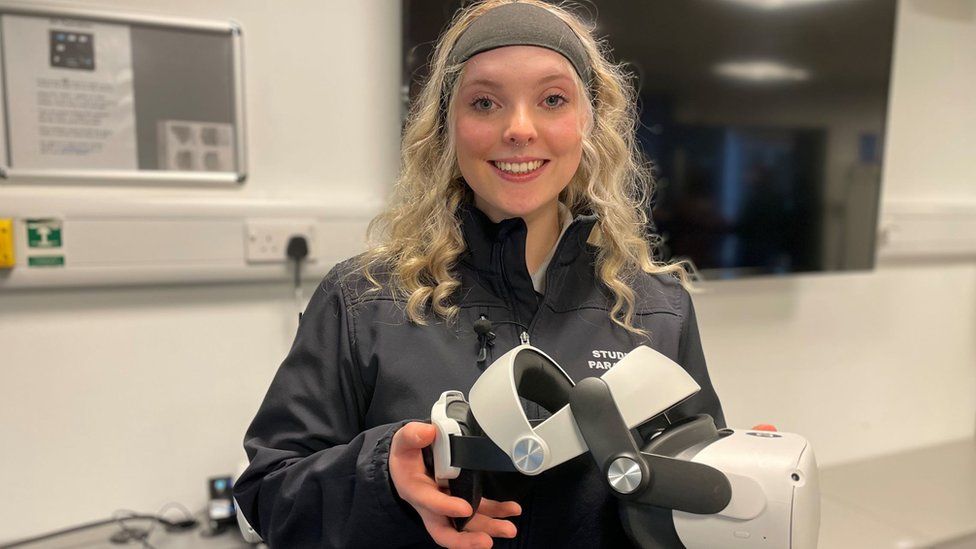'It’s quite trippy': How virtual reality helps trainee paramedics tackle a home birth crisis
- Published

For trainee paramedics, dealing with a home birth that goes wrong is about as stressful as it gets.
It happens rarely in the real world, so even out on placement with ambulance crews, it is not something students will necessarily encounter.
But an innovative university in East Lothian is now giving future first responders the chance to experience this crisis scenario in virtual reality.
By putting on a headset, the students are able to see a computer-generated version of a patient's home. They can ask the expectant mother questions and hear their responses.
The students' hand movements in the classroom are also detected by the headset. This lets them pick up and use the medical equipment in the virtual world.
"You feel that you're in their house, especially when you can see your hands and your interaction with the mother and the medical kit," said Julia Stevenson, a third-year student at Queen Margaret University in Musselburgh.
"When the baby popped out, the first time I did it, I got quite a shock because it was quite real."
Before the introduction of VR, students would sit in a classroom and go through possible scenarios using role-play techniques.
Some would pretend to be the patients, others would be the paramedics. But that approach has its drawbacks.
"It causes problems if the role-players are lacking confidence or over-enthusiastic and the key learning points can get lost," said lecturer Alex Williams.
Second-year student Bronte Haywood agrees. "We're not trained to be actors so it is quite difficult.
"Some people are better at it than others so it does quite vary the experience because you're trying to immerse yourself in to how that patient is presenting.
"It does make the role-play a little bit less realistic, whereas the VR puts you straight into an environment that's very realistic to how it's going to be in the outside world."
Bronte found she had a strong emotional response the first time she helped "deliver" a baby virtually.
"It was very real and it did give me a fright," the 22-year-old from Aberdeen said. "I'm not a gamer. I'm not a VR person.
"Initially it is a bit disorientating, but because I'm so involved in the situation interacting with the patient, I quickly got used to it and I almost forgot I was in a simulation."
Megan Johnston, a 24-year-old student from Cumbernauld, will spend time in a maternity unit later this term.
She said using the VR equipment had helped her confidence and made her less worried about her upcoming placement.
"It's very overwhelming to begin with," she said. "It's quite trippy in a way until you get used to it.
"This is a really hands-on job and getting experience in this virtual reality is definitely a better learning tool for visual learners like myself."
Using the VR technology, the five scenarios the students face are:
- a normal birth which acts as a warm-up as the students get comfortable using the equipment
- post-partum haemorrhage - a very dangerous situation when there is no access to operating theatres, unlike a hospital birth
- pre-eclampsia - which students must recognise and make the decision to get the patient to hospital immediately to avoid the situation deteriorating
- shoulder dystocia - where the students make decisions to try to best get the baby out for a safe delivery
- maternal sepsis - where the focus is on quickly identifying that the mother is unwell
Although these maternity complications are few and far between, lecturer Mr Williams said it was essential the students knew what to do in the event of an emergency.
"It's really important to say that these situations don't happen often in the real world," he said. "So students don't necessarily experience this on their placements.
"However, when these events do occur there is a high risk attached. That puts a lot of pressure on the students.
"VR allows them to make decisions in that environment over and over to build their confidence.
"By having a more prepared workforce who are confident with these scenarios, we can make it safer for the women giving birth."
Julia Stevenson, 32, from Glasgow, has been won over by the new technology.
"I've done maternity placements and I've seen what can go well, but also what can also go really wrong," she said.
"It's quite overwhelming, especially knowing the complications that can arise. VR definitely gave me the time to work out what to do in a safe and comfortable environment."
As well as teaching the students, Mr Williams has helped to develop the software for other areas, including dementia awareness.
"We've been using it here to give people an empathetic experience of dementia," he added. "Now we're using it to improve students' decision-making around maternity complications.
"When they go out into the real world they'll be more comfortable with that experience, because they've had a virtual experience of it before.
"That could relate to any uncommon but high-risk scenario. So the future could be perhaps major incidents.
"The headset would allow the students to experience some of the chaotic environment that we bring order to as emergency services."